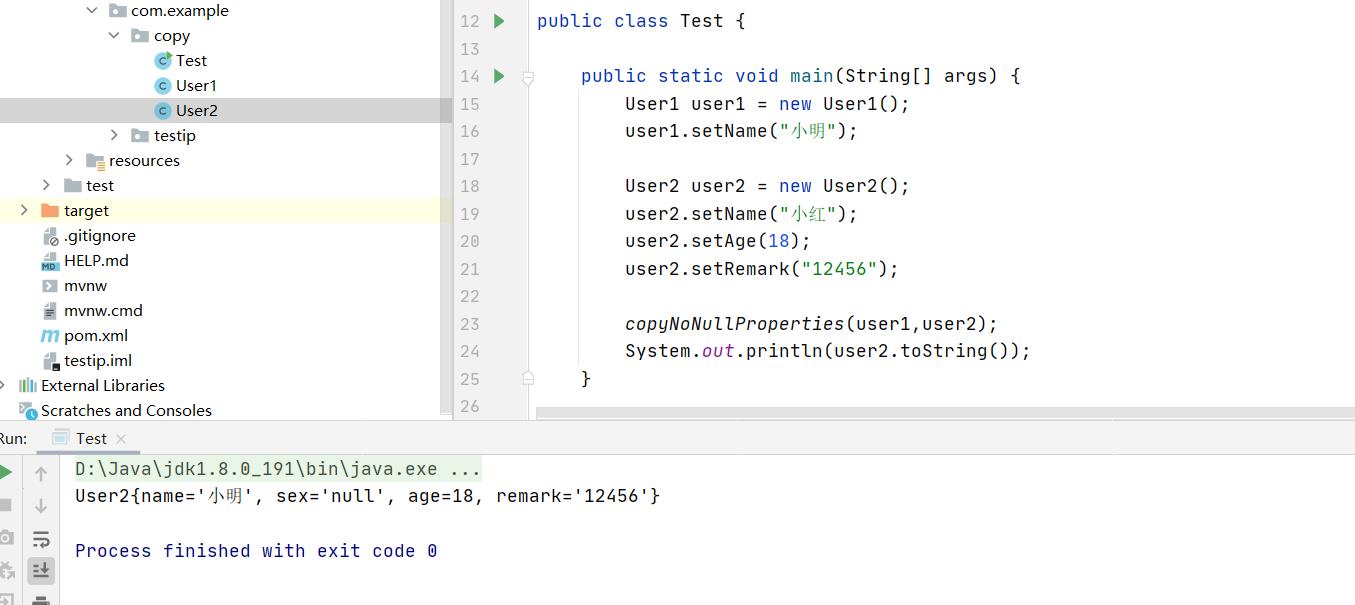Java将一个对象中非空的字段覆盖到另一个对象中
Posted *King*
tags:
篇首语:本文由小常识网(cha138.com)小编为大家整理,主要介绍了Java将一个对象中非空的字段覆盖到另一个对象中相关的知识,希望对你有一定的参考价值。
前缀:
在开发中我们现在将一个对象中的非空字段覆盖到另一个对象中,虽然BeanUtils.copyProperties()和PropertyUtils.copyProperties()方法也可以实现,但是它是将整个对象完全复制到另一个对象里,与我们预期的不一样,所以这里可以参考一下如下的代码:
具体方法:
/**
* 功能说明: 只复制source对象的非空属性到target对象上
* @param source
* @param target
* @throws BeansException
*/
public static void copyNoNullProperties(Object source, Object target) throws BeansException
Assert.notNull(source, "Source must not be null");
Assert.notNull(target, "Target must not be null");
Class<?> actualEditable = target.getClass();
PropertyDescriptor[] targetPds = BeanUtils.getPropertyDescriptors(actualEditable);
for (PropertyDescriptor targetPd : targetPds)
if (targetPd.getWriteMethod() != null)
PropertyDescriptor sourcePd = BeanUtils.getPropertyDescriptor(source.getClass(), targetPd.getName());
if (sourcePd != null && sourcePd.getReadMethod() != null)
try
Method readMethod = sourcePd.getReadMethod();
if (!Modifier.isPublic(readMethod.getDeclaringClass().getModifiers()))
readMethod.setAccessible(true);
Object value = readMethod.invoke(source);
// 这里判断以下value是否为空 当然这里也能进行一些特殊要求的处理 例如绑定时格式转换等等
if (value != null)
Method writeMethod = targetPd.getWriteMethod();
if (!Modifier.isPublic(writeMethod.getDeclaringClass().getModifiers()))
writeMethod.setAccessible(true);
writeMethod.invoke(target, value);
catch (Throwable ex)
throw new FatalBeanException("Could not copy properties from source to target", ex);
实践:
User1
public class User1
private String name;
private String sex;
private Integer age;
public String getName()
return name;
public void setName(String name)
this.name = name;
public String getSex()
return sex;
public void setSex(String sex)
this.sex = sex;
public Integer getAge()
return age;
public void setAge(Integer age)
this.age = age;
@Override
public String toString()
return "User1" +
"name='" + name + '\\'' +
", sex='" + sex + '\\'' +
", age=" + age +
'';
User2
public class User2
private String name;
private String sex;
private Integer age;
private String remark;
public String getName()
return name;
public void setName(String name)
this.name = name;
public String getSex()
return sex;
public void setSex(String sex)
this.sex = sex;
public Integer getAge()
return age;
public void setAge(Integer age)
this.age = age;
public String getRemark()
return remark;
public void setRemark(String remark)
this.remark = remark;
@Override
public String toString()
return "User2" +
"name='" + name + '\\'' +
", sex='" + sex + '\\'' +
", age=" + age +
", remark='" + remark + '\\'' +
'';
Test
import cn.hutool.core.lang.Assert;
import org.springframework.beans.BeanUtils;
import org.springframework.beans.BeansException;
import org.springframework.beans.FatalBeanException;
import java.beans.PropertyDescriptor;
import java.lang.reflect.Method;
import java.lang.reflect.Modifier;
public class Test
public static void main(String[] args)
User1 user1 = new User1();
user1.setName("小明");
User2 user2 = new User2();
user2.setName("小红");
user2.setAge(18);
user2.setRemark("12456");
copyNoNullProperties(user1,user2);
System.out.println(user2.toString());
/**
* 功能说明: 只复制source对象的非空属性到target对象上
* @param source
* @param target
* @throws BeansException
*/
public static void copyNoNullProperties(Object source, Object target) throws BeansException
Assert.notNull(source, "Source must not be null");
Assert.notNull(target, "Target must not be null");
Class<?> actualEditable = target.getClass();
PropertyDescriptor[] targetPds = BeanUtils.getPropertyDescriptors(actualEditable);
for (PropertyDescriptor targetPd : targetPds)
if (targetPd.getWriteMethod() != null)
PropertyDescriptor sourcePd = BeanUtils.getPropertyDescriptor(source.getClass(), targetPd.getName());
if (sourcePd != null && sourcePd.getReadMethod() != null)
try
Method readMethod = sourcePd.getReadMethod();
if (!Modifier.isPublic(readMethod.getDeclaringClass().getModifiers()))
readMethod.setAccessible(true);
Object value = readMethod.invoke(source);
// 这里判断以下value是否为空 当然这里也能进行一些特殊要求的处理 例如绑定时格式转换等等
if (value != null)
Method writeMethod = targetPd.getWriteMethod();
if (!Modifier.isPublic(writeMethod.getDeclaringClass().getModifiers()))
writeMethod.setAccessible(true);
writeMethod.invoke(target, value);
catch (Throwable ex)
throw new FatalBeanException("Could not copy properties from source to target", ex);
测试结果:

以上是关于Java将一个对象中非空的字段覆盖到另一个对象中的主要内容,如果未能解决你的问题,请参考以下文章